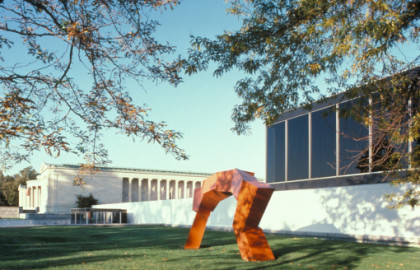Albright-Knox Art Gallery
The Buffalo Fine Arts Academy, founded in 1862, is the governing body of the Albright-Knox Art Gallery. It is among the oldest public arts organizations in the United States. A major event in the life of the Academy occurred with the construction of the Albright Art Gallery, a generous gift from Buffalo entrepreneur and philanthropist John J. Albright. Intended to serve first as the Fine Arts Pavilion of the Pan-American Exposition in 1901, it was completed too late for that purpose in 1905. The original building was designed by Edward B. Green, the distinguished Buffalo architect also responsible for the design of the Toledo Museum of Art and the Dayton Art Institute. Later, the Gallery was significantly enhanced with the addition of a new wing designed by Gordon Bunshaft of Skidmore, Owings and Merrill of New York. Made possible with major donations from Seymour H. Knox, Jr. and his family, and hundreds of other contributors, the new addition was dedicated in 1962, and the museum was renamed the Albright-Knox Art Gallery. Additional galleries are located in Clifton Hall, which is connected to the main Gallery by an underground pedestrian link.
Today, the Albright-Knox Art Gallery enjoys a worldwide reputation as an outstanding center of modern art. Thomas Hoving, art historian and former director of the Metropolitan Museum of Art, New York, recently said that "the Albright-Knox Art Gallery should be on everyone's list to see, for it's an overwhelming art experience. Small, intimate, and seductive, the museum has one of the most thumping modern and contemporary collections in the world." The Gallery's collection is especially rich in post-war American and European art, acquired mostly through the generosity of its patron, the late Seymour H. Knox, Jr. Abstract expressionism, pop art, and art of the 1970s through the end of the century are well represented by exceptional examples by artists such as Gorky, Pollock, Warhol, and Johns. In addition, the Gallery visitor will find that the permanent collection offers a panorama of art through the centuries. Impressionism and Post-Impressionism are well represented by such leading French artists of the nineteenth century as Gauguin and van Gogh. Cubism, surrealism, constructivism, and other trends of the revolutionary twenties and thirties are documented by a large selection of significant works by Picasso, Braque, Matisse, Derain, Miró, Mondrian, Rodchenko, and others.
MISSION The Albright-Knox Art Gallery, one of the nation's oldest public arts organizations, has a clear and compelling mission to acquire, exhibit, and preserve both modern and contemporary art. It focuses especially on contemporary art, with an active commitment to taking a global and multidisciplinary approach to the presentation, interpretation, and collection of the artistic expressions of our times. In an enriching, dynamic, and vibrant environment that embraces diverse cultures and traditions, the Gallery seeks to serve a broad and far-reaching audience.
- Vogel 50x50 works at this institution
- Website:
- http://www.albrightknox.org/
- Exhibitions:
-
- Charles Clough, Recent Work. Albright-Knox Art Gallery, Buffalo, New York, April 8, 1983 — May 8, 1983.
- Fifty Works for Fifty States: The Dorothy and Herbert Vogel Collection. Albright-Knox Art Gallery, Buffalo, New York, January 22, 2010 — May 9, 2010.
